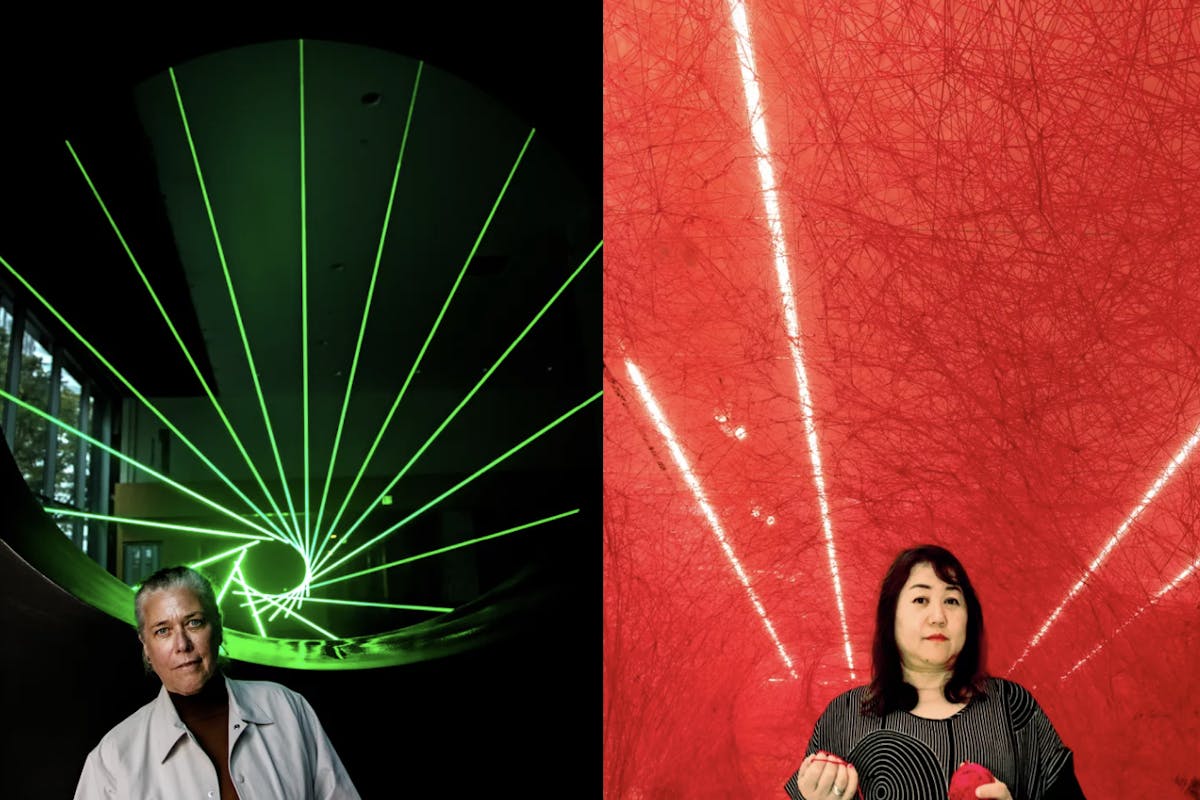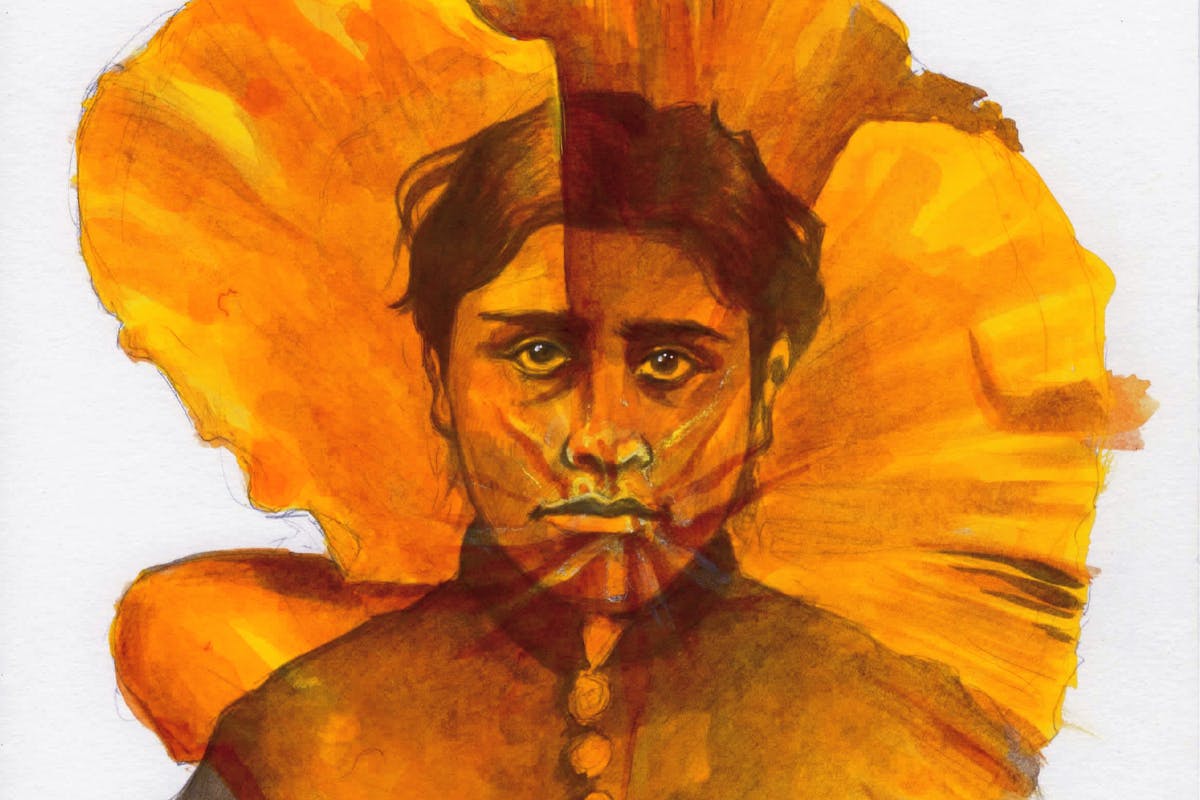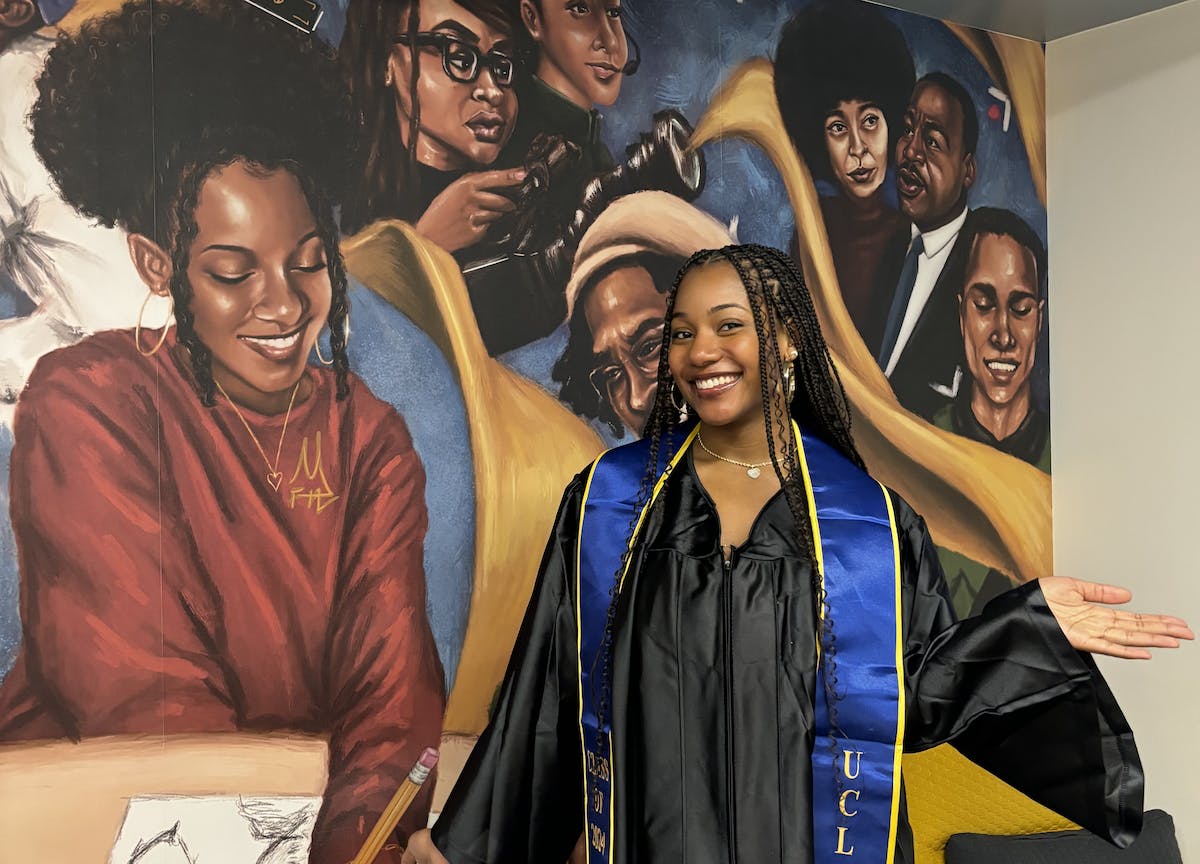16 high-intensity lasers, 800 pounds of blood-red yarn: The Hammer goes big in new immersive spaces

The exterior of the Hammer Museum is ensconced in silvery sheets of rain and heavy fog today. But inside, the atmosphere is even more dramatic.
The lobby is completely enveloped in an intricate web of blood-red yarn. Lacy swaths of it drape from the ceiling and crawl up the walls. Threads of the material coil around the stair handrails and spread across the ceiling, like a fungus, nearly obscuring it.
Meantime, in another area of the museum — a cavernous former bank space turned exhibition gallery — there’s what appears to be a glimmering, time-travel wormhole. The dimly lit gallery fills with mist oozing from ceiling jets and glowing neon-green lasers cut through the fog, illuminating it along with wafting poofs of dust.
The unusual environments in the lobby and bank gallery are large-scale, immersive installations by Japanese artist Chiharu Shiota and Rita McBride, respectively. The Hammer is unveiling the final phase of its two decade, $90-million expansion and renovations project, designed by Michael Maltzan Architecture, this week. In addition to a new sculpture terrace, featuring a monumental piece by Sanford Biggers, the project includes a brand new lobby and entrance on the corner of Wilshire and Westwood boulevards and a massive gallery for large-scale works and performances, among other uses, in the former City National Bank space next door.
It’s a critical juncture for the museum, and Shiota and McBride are the perfect artists to create the inaugural works for the new spaces that house them, says Hammer curator Erin Christovale.
“We’re working with ambitious artists who are women who are constantly pushing the bounds of what is considered to be women’s work, who are pushing the bounds of sculpture and installation,” Christovale says. “And I think that’s kind of what the Hammer has always represented — supporting, particularly, women and having a feminist bent.”
Standing inside Shiota’s “The Network” feels like nesting inside a human heart valve. The veinlike threads of yarn form canopies over the lobby staircase, so that visitors must pass through tunnels of it to enter the museum. As the installation is underway, spools of yarn lay on the concrete floor around the lobby and heaping piles of loose thread sit in corners.
The Berlin-based Shiota, who started off as a painter, considers the work to be a three-dimensional, sculptural “drawing in space.”
She says the work, as its title suggests, is about connections — community networks, neural networks, computer networks. The origin story for the work is a Japanese myth, she says. As the story goes: When a baby is born, it has an imaginary piece of red thread attached to their finger that then connects to everyone they meet in their lifetime.
“If you’re living in society, everyone is connected with an invisible line,” Shiota says.
The piece is also site-specific, relating to the museum at this important moment in its history. The web of yarn crisscrossing the lobby refers to connections between the artist, her team, the Hammer and the visitors who will fill it. It also relates to infinite interpretations of the many artworks on view at the Hammer.
“People coming to the museum, the contemporary art has no [standard interpretation],” Shiota says. “Everyone can think freely. It’s open. 100 people, 100 opinions. Different kinds of emotions.”
Webs of yarn are Shiota’s signature materials, says Christovale, who curated “The Network.” Shiota presented a similar piece at the 2015 Venice Biennial. She’s drawn to yarn for its versatility, she says. “ I like this material because sometimes it tangles, sometimes you cut it, losing it, or there’s tension. It’s like relationships between human beings.”
To make the piece, the Hammer brought in 800 pounds of yarn. Shiota and her team have been weaving for two weeks — it will have taken three weeks by the time the piece debuts.
Sitting in a covered portion of the museum’s courtyard as the rain comes down around her, Shiota fiddles with a ball of yarn on her lap, repeatedly winding, twisting and looping the thread between her fingertips. “Look, you can see [it] through the glass!” she says of the artwork, while crossing the courtyard heading back to the lobby.
She’s especially excited, she says, about how visible the work is from the street. The old lobby had fewer and smaller windows; the new space has soaring windows along the wall that faces Wilshire. From the outside, Shiota’s bright red artwork pops against the building’s gray and beige exterior and is visible to passersby on foot and in their cars.
“It’s very important, that quick impression,” she says. “People driving by, maybe they want to come in. Then they [become curious] and they think, ‘Oh, art is interesting.’”
Over in the old bank, it’s quiet and dark and eerily still before the lights come on. Then, in an instant, the space is transformed into an ethereal, sci-fi-like setting. The focus of McBride’s “Particulates” is a black-painted wall with a giant cylindrical cut out and a grouping of 16 high-intensity green lasers that shoot through it. They interlock, forming a three-dimensional-looking beam comprised of geometric patterns — a rotated hyperbolic parabola . The glowing beam morphs, depending on the angle the piece is viewed from — elongated and tunnel-like from one angle, twisted and more compact from another — giving the lightwork an almost organic, living feel.
The lasers come to life where they intersect with mist and bits of dust in the air, appearing especially bright and animated. The work reflects off of surfaces in the room, with cross sections of it shimmering against the bank vault, the walls and the windows — even through the windows, onto Biggers’ sculpture outside and the sidewalk beyond.
The artist, who splits her time between Düsseldorf, Germany, and Los Alamos, Calif., considers the work to be an immersive sculptural installation that’s also a drawing in space. She asked the Hammer to keep much of the bank space “raw” as the museum was renovating. The architect kept the wood veneer wall paneling, marble administrative counters, the original marble terrazzo floor and the bank vault. The museum sanded and resurfaced the floor directly underneath the lasers, so that water would pool there and create a reflective surface.
“Rita’s work almost always engages with architecture,” says Hammer chief curator, Connie Butler, who curated this presentation of “Particulates.” “She wanted the residue of the corporate ruin.”
In that way, “Particulates” is not only site-specific but also site-integrative, with remnants of the bank space — the debris left behind — serving as a material in the artwork in addition to the lasers, the mist and the dust particles.
“I was excited to have a somewhat politically charged space — banks are charged spaces,” McBride says. “The vocabulary of this space was very specific in terms of its marble and its granite and paneling — it felt very ’80s to me — and I wanted to keep some of that vocabulary present instead of stripping everything down to a white cube or a black cube, things that would make it more neutral.”
The work is also about time travel, light and space, connections and quantum physics.
“It’s about this possibility of being able to connect with unknown places,” McBride says. “Black holes and traveling these distances that are unknown to us or where they take us. It’s also an opportunity to get out of the consciousness of the moment and imagine a much larger universe.”
A version of “Particulates” was shown in the 2016 Liverpool Biennial; another was presented at the Dia Art Foundation in 2017. Both of those exhibitions were in enclosed spaces with no windows. The bank gallery includes nearly floor-to-ceiling windows on two sides, which are heavily tinted for this exhibition so that the gallery remains dark and the lasers pop.
“This is the first time I’ve been able to work with real life coming in,” McBride says.
As such, the work changes with the weather, the moisture in the air, the time of day and the light. “I’m working with light in a different way, daylight,” McBride says. “It changes every time. It’s amazingly flexible and beautiful.”
The work is part of the Hammer’s permanent collection, but the museum has never shown it before — it hasn’t had a big enough space until now. It plans to use the bank gallery for other large-scale works in the collection that haven’t been shown yet. “Works where the scale is well suited,” Butler says. “Or that would just look great in a space like this, a semi-raw space with high ceilings.”
That includes a heavy, tall sculpture by Lauren Halsey, a monument to Black history, and a multiscreen video installation by Paul Chan.
While “The Network” and “Particulates” are entirely different artworks — the former more tactile and textural and the latter more digital and ephemeral — they appear to be in direct conversation. Both are comprised of interlocking threads — webs — that evoke powerful, visceral reactions.
And both works, on the occasion of the new Hammer Museum debut, are about connections.
“They set the tone,” Christovale says. “That we’re taking a leap.”
– Los Angeles Times

